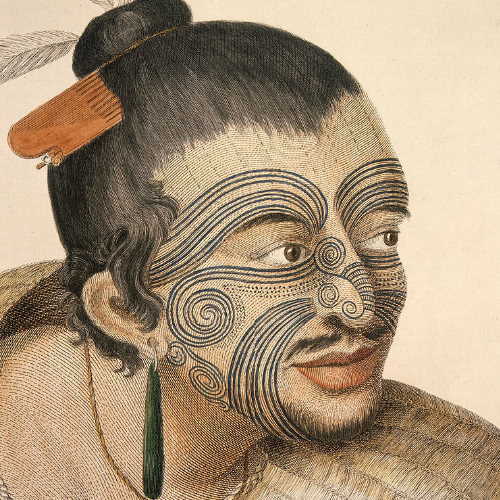Maori Wars
The Maori Wars took place from 1845 to 1872 between the New Zealand Colonial government and allied Maori on one side and Maori and Maori-allied settlers on the other. Though the wars were initially localised conflicts triggered by tensions over disputed land purchases, they escalated dramatically from 1860 as the government became convinced it was facing united Maori resistance to further land sales and a refusal to acknowledge Crown sovereignty.
The cause of all conflict between whites and the Maori people was land. The first conflict occurred in 1845 when Maori Chief Hone Heke attacked the settlement of Russell in the Bay of Islands on the North Island. British forces where sent from Auckland to defeat and capture Heke but the Maori chief and his warriors where skilled in the art of war and it took a local militia, troops rushed in from Australia and the diplomacy of the South Australian governor George Grey to force Hone Heke to sue for peace. This was considered the first Maori War.
By 1860 the grab for land again sparked conflict between whites and the Maoris, this time in the Waitara River area. The British with their 1000 troops soon found themselves facing 20,000 skilled Maori warriors. Again the Australian colonies was asked for urgent assistance. The colonies rallied and sent troops. The colony of Victoria even sent its entire navy, which comprised the steam corvette HMVS Victoria. New South Wales also sent gun ships to support the troops. At the end of 1862 Governor George Grey again used his diplomatic skills to bring an end to the conflict.
By 1860 the grab for land again sparked conflict between whites and the Maoris, this time in the Waitara River area. The British with their 1000 troops soon found themselves facing 20,000 skilled Maori warriors. Again the Australian colonies was asked for urgent assistance. The colonies rallied and sent troops. The colony of Victoria even sent its entire navy, which comprised the steam corvette HMVS Victoria. New South Wales also sent gun ships to support the troops. At the end of 1862 Governor George Grey again used his diplomatic skills to bring an end to the conflict.
The Maori Wars
Who are the Maori?
The Maori are the indigenous Polynesian people of mainland New Zealand. Maori originated with settlers from eastern Polynesia, who arrived in New Zealand in several waves of waka (canoe) voyages between roughly 1320 and 1350. Over several centuries in isolation, these settlers developed their own distinctive culture, whose language, mythology, crafts and performing arts evolved independently from those of other eastern Polynesian cultures.


British soldiers of the 57th Regiment taking a Maori redoubt on the Katikara River in Taranaki during the Land Wars.
Archive photo: Getty Images
Archive photo: Getty Images
Only a year later war broke out again, this time in the Waikato area. Again Australian troops came to the aid of local British forces.
In the end, the struggle lasted for 12 years and required the intervention of British regular troops to achieve victory. The Maoris’ stubborn resistance meant that they were eventually admitted to the franchise as well as enjoying a far higher status in colonial society than, for example, the Aboriginals of Australia.
In the end, the struggle lasted for 12 years and required the intervention of British regular troops to achieve victory. The Maoris’ stubborn resistance meant that they were eventually admitted to the franchise as well as enjoying a far higher status in colonial society than, for example, the Aboriginals of Australia.

Hōne Wiremu Heke Pōkai, born Heke Pōkai and later often referred to as Hōne Heke, was a highly influential Māori chieftain and a war leader in northern New Zealand. Hōne Heke fought with Hongi Hika, an earlier war leader of the Ngāpuhi, in the Musket Wars. Hōne Heke is considered the principal instigator of the Flagstaff War in 1845–46.
Exercises:
1. Re-read the text, make up a list of necessary vocabulary and answer the following questions:
1) Who are the Maori people?
2) What is the cause of Maori Wars?
3) What is the conclusion of the First and Second Maori Wars?
4) How did the Third Maori War begin?
5) What was the ultimate outcome of the Maori Wars?
2. Find in the text the following words and word combinations, find a Russian equivalent for them and add them to your working vocabulary:
settlement; militia; governor; to sue for peace; grab for land; to rally; indigenous; performing arts; to be admitted to the franchise.
3. Use the words from the Exercise 2 in your own sentences.
4. Write your summary of the text, emphasising in it:
a) its subject matter,
b) the facts discussed,
c) the author's point of view on these facts.
1) Who are the Maori people?
2) What is the cause of Maori Wars?
3) What is the conclusion of the First and Second Maori Wars?
4) How did the Third Maori War begin?
5) What was the ultimate outcome of the Maori Wars?
2. Find in the text the following words and word combinations, find a Russian equivalent for them and add them to your working vocabulary:
settlement; militia; governor; to sue for peace; grab for land; to rally; indigenous; performing arts; to be admitted to the franchise.
3. Use the words from the Exercise 2 in your own sentences.
4. Write your summary of the text, emphasising in it:
a) its subject matter,
b) the facts discussed,
c) the author's point of view on these facts.
